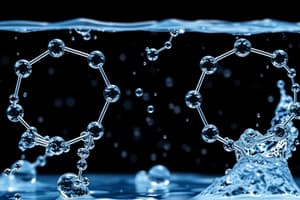Podcast
Questions and Answers
What is the polarity of water?
What is the polarity of water?
- Both hydrogen atoms are negatively charged
- Water has polar covalent bonds (correct)
- Oxygen is partially negative and hydrogen is partially positive (correct)
- Water is nonpolar
What causes polarity in water?
What causes polarity in water?
Electronegativity
What is a covalent bond?
What is a covalent bond?
A chemical bond formed when two atoms share electrons.
What does hydrophilic mean?
What does hydrophilic mean?
What does hydrophobic mean?
What does hydrophobic mean?
How do water molecules form?
How do water molecules form?
Why does water stick to itself?
Why does water stick to itself?
What is a hydrogen bond?
What is a hydrogen bond?
What is cohesion?
What is cohesion?
What is surface tension?
What is surface tension?
What is adhesion?
What is adhesion?
What is capillary action?
What is capillary action?
Why is water like a magnet?
Why is water like a magnet?
What is the difference between hydrogen bonds and covalent bonds?
What is the difference between hydrogen bonds and covalent bonds?
What is the difference between polar covalent and non-polar covalent bonds?
What is the difference between polar covalent and non-polar covalent bonds?
Why does ice float in liquid water?
Why does ice float in liquid water?
Why do cracks in pavement widen to become potholes in winter?
Why do cracks in pavement widen to become potholes in winter?
Where is the negative charge located on a water molecule?
Where is the negative charge located on a water molecule?
Why can polar molecules dissolve in polar solvents?
Why can polar molecules dissolve in polar solvents?
What is condensation?
What is condensation?
What is sublimation?
What is sublimation?
What is deposition?
What is deposition?
Water has a __________, it can absorb a large amount of heat before a change in temperature takes place.
Water has a __________, it can absorb a large amount of heat before a change in temperature takes place.
Why is water a more effective coolant than alcohol for the body?
Why is water a more effective coolant than alcohol for the body?
Flashcards are hidden until you start studying
Study Notes
Polarity of Water
- Water exhibits polarity due to polar covalent bonds between hydrogen and oxygen, with hydrogen being partially positive and oxygen partially negative.
- Electronegativity is the driving force of polarity, measuring the ability of atoms to attract bonding electrons.
Bonding Types
- Covalent bonds involve the sharing of electrons between atoms.
- Hydrogen bonds are attractions between a positively charged hydrogen atom and a negatively charged atom.
- Polar covalent bonds share electrons unequally between atoms, while non-polar covalent bonds share electrons equally.
Molecular Properties
- Hydrophilic substances are attracted to water, whereas hydrophobic substances repel water.
- Cohesion refers to the attraction between molecules of the same substance, contributing to high surface tension.
- Adhesion is the attraction between molecules of different substances, facilitating water's interaction with various materials.
Water Behavior
- Capillary action relies on both cohesion and adhesion, allowing water to move against gravity, such as in plant stems.
- Water's polarity causes it to act like a magnet, with hydrogen molecules attracting to negatively charged regions of other molecules.
Ice and Density
- Ice floats on water due to its lower density compared to liquid water. Water is unique in that its solid form is less dense than its liquid form.
Seasonal Changes and Effects
- Water expands upon freezing, leading to the widening of cracks in pavement during winter as water seeps into them.
Solubility
- Polar solvents dissolve polar solutes, highlighting the principle "like dissolves like" in chemistry.
Phase Changes
- Condensation is when water changes from gas to liquid.
- Sublimation is the transition from solid directly to gas.
- Deposition refers to water changing from gas directly to solid.
Heat Properties
- Water has a high specific heat, allowing it to absorb significant amounts of heat before temperature changes occur.
- Water is a more effective coolant than alcohol due to its higher heat of vaporization, enabling the body to maintain lower temperatures.
Studying That Suits You
Use AI to generate personalized quizzes and flashcards to suit your learning preferences.




